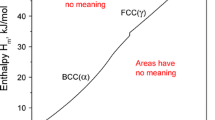Abstract
The high-pressure behavior of Keokuk kaolinite has been studied to 9.5 GPa by infrared spectroscopy using synchrotron radiation. The kaolinite-I → kaolinite-II and kaolinite-II → kaolinite-III transformations have clear spectroscopic expression, with discontinuities coinciding with the transformation pressures bracketed by X-ray diffraction (Welch and Crichton in Am Mineral 95:651–654, 2010). The experimental spectra have been interpreted from band assignments derived from density functional theory for the structures of kaolinite-II and kaolinite-III, using as starting models the ab initio structures reported by Mercier and Le Page (Acta Crystallogr A B64:131–143, 2008, Mater Sci Technol 25:437–442, 2009) and unit-cell parameters from Welch and Crichton (Am Mineral 95:651–654, 2010). The relaxed theoretical structures are very similar to those reported by Mercier and Le Page (Acta Crystallogr A B64:131–143, 2008, Mater Sci Technol 25:437–442, 2009) in their theoretical investigation of kaolinite polytypes at high pressure. The vibrational spectra calculated from the quantum-mechanical analysis allow band assignments of the IR spectra to be made and provide insights into the behavior of different OH environments in the two high-pressure polytypes. The single perpendicular-interlayer OH group of kaolinite-III has a distinctive spectroscopic signature that is diagnostic of this polytype (ν = 3,595 cm−1 at 9.5 GPa) and is sensitive to the compression/expansion of the interlayer space. This OH group also has a distinctive signature in the calculated spectra. The spectra collected on decompression are those of kaolinite-III and persist largely unchanged to 4.6 GPa, except for a continuous blue shift of the 3,595 cm−1 band to 3,613 cm−1. Finally, kaolinite-I is recovered at 0.6 GPa, confirming the kaolinite-III → kaolinite-I transformation previously observed by X-ray diffraction, and the irreversibility of the kaolinite-II → kaolinite-III transformation. The ambient spectra collected at the start and finish of the experiment are those of kaolinite-I, and start/finish band frequencies agree to within 6 cm−1.





Similar content being viewed by others
References
Balan E, Saita MA, Mauri F, Calas G (2001) First-principles modeling of the infrared spectrum of kaolinite. Am Mineral 89:1321–1330
Balan E, Lazzeri M, Saitta AM, Allard T, Fuchs Y, Mauri F (2005) First-principles study of OH stretching modes in kaolinite, dickite and nacrite. Am Mineral 90:50–60
Balan E, Blanchard M, Hochepied J-F, Lazzeri M (2008) Surface modes of the infrared spectra of hydrous minerals: the OH stretching modes of bayerite. Phys Chem Miner 35:279–285
Balan E, Delattre S, Guillaumet M, Salje EKH (2010) Low-temperature infrared spectroscopic study of OH stretching modes in kaolinite and dickite. Am Mineral 95:1257–1266
Beran A (2002) Infrared spectroscopy of micas. Rev Mineral Petrol 46:351–367
Bish DL (1993) Rietveld refinement of the kaolinite structure at 1.5 K. Clays Clay Miner 41:738–744
Boehler R, Ross M, Boercker DB (1996) High-pressure melting curves of alkali halides. Phys Rev A 53(2):556–563
Dera P, Prewitt CT, Japel S, Bish DL, Johnston CT (2003) Pressure-controlled polytypism in hydrous layered materials. Am Mineral 88:1428–1435
Farmer VC (1974) The infrared spectra of minerals. Mineralogical Society, London
Giannozzi P, Baroni S, Bonini N, Calandra M, Car R, Cavazzoni C, Ceresoli D, Chiarotti GL, Cococcioni M, Dabo I, Dal Corso A, de Gironcoli S, Fabris S, Fratesi G, Gebauer R, Gerstmann U, Gougoussis C, Kokalj A, Lazzeri M, Martin-Samos L, Marzari N, Mauri F, Mazzarello R, Paolini S, Pasquarello A, Paulatto L, Sbraccia C, Scandolo S, Sclauzero G, Seitsonen AP, Smogunov A, Umari P, Wentzcovitch RM (2009) Quantum ESPRESSO: a modular and open-source software project for quantum simulations of materials. J Phys Condens Mat 21:395502
Hawthorne FC, Della Ventura G (2007) Short-range order in amphiboles. Rev Mineral Petrol 67:173–222
Jennings ES, Montgomery W, Lerch Ph (2010) The stability of coronene at high temperature and pressure: implications for hydrocarbons in planetary interiors. J Phys Chem B 114(48):15753–15758
Johnston CT, Wang SL, Bish DL, Dera P, Agnew SF, Kenney JWIII (2002) Novel pressure induced phase transformations in hydrous layered materials: a comparative single crystal high pressure Raman/XRD study of dickite and gibbsite. Geophys Res Lett 29:1029
Mao HK, Xu J, Bell PM (1986) Calibration of the ruby pressure scale to 800-kbar under quasi-hydrostatic conditions. J Geophys Res Solid Earth Planets 91(B5):4673–4676
Mercier PHJ, Le Page Y (2008) Kaolin polytypes revisited ab initio. Acta Crystallogr A B64:131–143
Mercier PHJ, Le Page Y (2009) Ab initio exploration of layer slipping transformations in kaolinite up to 60 GPa. Mater Sci Technol 25:437–442
Perdew JP, Burke K, Ernzerhof M (1996) Generalized gradient approximation made simple. Phys Rev Lett 77:3865–3868
Stixrude L (2002) Talc under tension and compression: spinodal instability, elasticity, and structure. J Geophys Res 107:2327
Welch MD, Crichton WA (2010) Pressure-induced transformations in kaolinite. Am Mineral 95:651–654
Wojdyr M (2010) Fityk: a general-purpose band fitting program. J Appl Crystallogr 43:1126–1128
Acknowledgments
The Swiss Light Source is acknowledged for the provision of beam-time and Luca Quaroni for technical support. We thank Patrick Mercier and an anonymous reviewer for their perceptive and constructive reviews and Associate Editor Milan Rieder for his guidance on the preparation of the revised manuscript. This work was performed using HPC resources from GENCI-IDRIS (Grant 2011-i2011041519).
Author information
Authors and Affiliations
Corresponding author
Electronic supplementary material
Below is the link to the electronic supplementary material.
Rights and permissions
About this article
Cite this article
Welch, M.D., Montgomery, W., Balan, E. et al. Insights into the high-pressure behavior of kaolinite from infrared spectroscopy and quantum-mechanical calculations. Phys Chem Minerals 39, 143–151 (2012). https://doi.org/10.1007/s00269-011-0469-5
Received:
Accepted:
Published:
Issue Date:
DOI: https://doi.org/10.1007/s00269-011-0469-5




